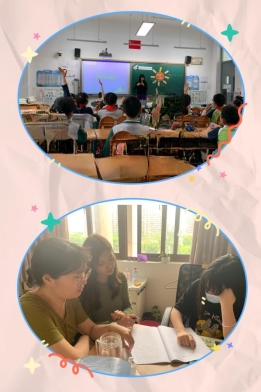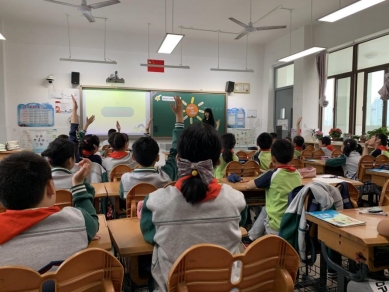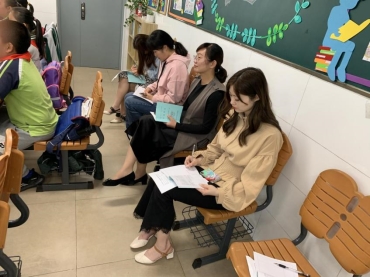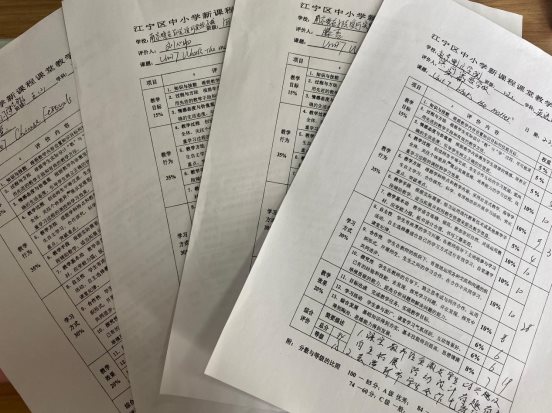2020-2021学年度第二学期三四年级英语备课组第三次活动
思维导图在小学故事版块教学的运用与研究
作者: 罗文涛 | 发布时间: 2021/5/21 9:40:24 | 3290次浏览2020-2021学年度第二学期小学英语中低年段备课组活动
——思维导图在小学故事版块教学的运用与研究
2021.5.20
为了提高英语课堂教学效率,提升我校英语教师教研教学水平,促进教师自身的学习和教学水平的发展,小学英语三四年级备课组活动如期进行,本次执教公开课的是四年级的洪宇老师。洪老师执教课题为四年级下学期Unit7 What’s the matter?第一课时Story time板块。
一、活动安排
1、时间:5月19日上午9:25——10:50
2、组员:刘心雨、林婉莹、周晓雅、洪宇、李希、张柳、滕杏
3、地点:四(2)班
4、内容:四年级下册Unit7 What’s the matter?
5、流程:试上、磨课、听课、记录和研讨
6、活动提示:上课教师课前调试好班级多媒体,准备好教具,分好小组;组员认真听课、做好听课记录,给予评课意见;共同研讨
7、活动报道:撰稿人:洪宇,校对人:李希,审核人:宋萍
二、活动记录
1、教学过程、课后反思
Period | 第一课时 | 教学内容 Teaching Contents | Unit7 What’s the matter? Story time | ||
教学目标 Teaching Aims | |||||
1. Ss can be able to understand the story by the end of this lesson with the help of teacher. 2. Ss can read the story fluently in groups after different ways of reading. 3. Ss can try to act out the story with emotions in groups of three by the help of blackboard design. | |||||
教学重点 Teaching Key Points | |||||
1. Ss can learn to understand, speak, read and write “thirsty”, “hungry”, “ill”, “tried” and “water”. 2. Ss can understand the key sentence “What’s the matter?” and its answer “I’m …” 2. Ss can try to act out the story with emotions. | |||||
教学难点 Teaching Difficult Points | |||||
1. Ss know how to read “thirsty” “water” and “tired” correctly and clearly. 2. Ss know how to try to express feelings. 3. Ss know how to use “I want to …” | |||||
教具准备 Teaching Aids | |||||
PPT、人物头饰、卡片、磁条、服装类实物等 | |||||
课前自主预习 Independent Preview Before Class | |||||
1.通过自主阅读,了解课文大意。 2.勾画出生词,试着了解其发音和意思。 3.听录音,试着跟读课文。尤其是发音难的单词:trourses,gloves等。 | |||||
教 学 过 程 Teaching Procedures | 修改或反思 Adjustment or Reflection | ||||
Step1 T: Boys and girls. We’re going to learn Unit7 What’s the matter. First, let’s have a look at our learning aims. After this lesson, I hope you can 1. understand the story 2. read the story fluently 3. try to act out the story in groups. Do you understand? step and get the biggest star.
Step2 1. Play a game--Quick response T: First, I have a game for you. If you see a word or a picture, Please read it out loudly. If you see a (笑脸) , please say “Happy ”
2. I can say T: Good eyes. Are you happy now? I’m happy too. And I want to sing. What about you? I’m . I want to . T: 4 people in a group and try to say about yourself.
3. T: You know I want to sing. Do you want to sing with me? And our friend wants to join us. Now let’s sing and dance with him. First, please do with me. Walking, Hop, Running; Up and down.
4. I can sing and do. Step3 1. I can ask T: (叹口气)I’m tired. Are you tired? How about Liu Tao? He is not happy now. Let’s care about him. Try to ask with your partner. Are you ...?
2. T: Good questions. What’s the matter with Liu Tao? Let’s ask him together. What’s the matter? T: You please, ask him.
2. I can watch and answer T: What’s the matter with Liu Tao? Let’s listen to the tape and try to find the answers. T: What’s the matter? I’m…
C. ill D. Tired (教thirsty, tired并板书)
4. I can listen and match. T: We know Liu Tao is thirsty and tired. What does he want to do? Let’s listen and match. T: Now you can say the answers like this: I’m… I want to… .
5. I can read and find T: Liu Tao is not so good. Here come Dad and Mum. How can they care about Liu Tao? Now open your books and turn to page 44. read the story by yourself. Underline the sentences about Dad and Mum.
6. I can imitate. T: You did a good job. Now, boys and girls. I think you know the story. let’s listen and repeat.
7. I can read T: Now it’s our reading time. 3 people in a group and choose one way to read the story. (1)Read in roles (2)Read with Miss Yang (3)Read together (4)... If you read correctly, you can get one star. If you read fluently, you can get two stars. If you read with emotions and actions, you can get three stars.
Step4 1. I can act T: You read well. Now close your books. It’s our acting time . (Give an example) Still 3 people in a group and try to act out the story. If you act correctly, you can get one star. If you act with actions, you can get two stars. If you act vividly, you can get three stars.
Step5 1. Enjoy a story. T: Liu Tao wants to go to bed. But, look, there is a book on the bed. Let’s read the book together. It tells about a story about “ The little match girl” The little match girl walks in the street. Nobody buys her match. She is very hungry, thirsty and tired. And at last, she is ill and falls down. What a poor girl! Do you want to help her?
2. I can say T: Good children! If you meet little match girl. What will you say? Please talk about it with your partners. And one of you is little match girl. The sentences may help you!
3. (情感教育) T: Happiness is to help others. Try your best to help others, then they will have a better life.
Step5 Homework 1. Act out the story with your partners. 2. Make a new story about ” Little match girl”. You can draw some pictures. Then put them on the walls of our classroom. |
| ||||
(分层)作业设计 Homework | |||||
★ 1.Read the dialogues after the tape and imitate the pronunciation. 2.Read and recite Story time. | ★★ 1.Retell the story. | ||||
板书设计 Blackboard Writing | |||||
(上课时设计成一个太阳,若干云朵,把单词和句型填入树中。) Unit7 What’s the matter ? What’s the matter?I’m....
| |||||
教后反思 Teaching Reflection After Class | |||||
在正式上课时,我用的自己班级,这个班比较活泼,跟我也比较熟,所以很了解我的课堂指令语,这也有利于课堂中的教学安排。整个课堂教学算是比较顺利,从一开始的游戏,唱歌和跳舞就迅速调动了课堂气氛,进入文本学习后,我采取了看动画选择答案,听动画匹配答案,自读课文寻找答案,跟录音模仿阅读,3人一组选方式阅读等,经过不同方式的文本处理,让学生对文本熟悉后再进行表演,因为文本比较短,所以学生已经能够脱稿表演,这也达到了本节课学习目标之一:初步表演课文。最后的巩固环节,设计的《卖火柴的小女孩》,学生比较熟悉,演起来也得心应手,比我示范时好很多。 但是,在本节课教学过程中也存在一些问题。1. 秩序不是很好,因为学生与我比较熟悉,所以学生比较放得开,这也导致了在有些环节上学生急于表现而忽略了课堂的秩序;2.学生评价上有些杂乱。为了充分给学生自主权,所以在朗读和表演环节设计了让台下的学生评价,学生意见不统一时课堂上会同时出现多种声音,有些乱。这也是我在之后教学中需要注意的地方,既给学生自主权,又要掌握适量的度。3. 黑板上的评价表缺少最终总结。我在上课伊始就设计了评价表,学生的表现都在表上体现。最后下课时我忘了总结评价表,在学生起立准备离开时才想起。这个可能会让学生有些失望。需要注意。 | |||||
三、课前准备
1.试上与组内研讨

2、板书准备

3、正式上课展示

4、教师研讨与反馈

5.教师评价归纳

6.活动反思
英语教学的目的主要是培养学生掌握并运用英语的能力,英语教学应该为学生创设他们喜闻乐见的合适的情境,给予他们充分的时间和空间,让他们成为学习的主人。 作为一名英语教师,首先应该激发学生学习英语的兴趣和积极性,增强学生的记忆效率,以达到最终的教学目的。如果一味地采用传统的英语教学方法讲授语言规则,让学生脱离语言环境去做大量机械、枯燥乏味的知识训练,学生学习兴趣当然不高。因而,在本单元中,我设计了很多活动,让学生在情景中练习what’s the matter? 增强学习的兴趣,锻炼了口语表达能力。在活动的开展过程中,我发现活动的效能远不如自己所期望的那样。例如,在活动伊始,我过高的估计学生的'词汇量口语表达能力。大多数学生无法在头脑中对生活中的“疾患”没有认识,不能用英语完整地表达出来,有的甚至对书本中出现过的“背疼,手臂疼”等复述都存在困难。因此,活动的设计以及活动中出现的意外状况都需要设计者在之前进行周密思考及在课堂上的变通。现对如何发挥活动的效能作如下反思:
(一) 设计与学生实际英语水平相当的活动。
由于教师本人所任教的两个班级的学生的结构、层次和能力都存在有一定的差异。因此在备课过程中,教师一定要认清学生的英语实际水平。笔者在本活动的开始时,高估了学生词汇量口语表达能力。在及时认识这一不足后,调整了呈现与说的顺序,让学生看了再说,再想,再反应。虽然活动也延续了下去,但说的作用似乎不大。笔者在课后与学生的交流中了解,学生只是对老师所呈现的情况有所思考,对于没有呈现的部分还不太明确,甚至没有思考,去探究。在了解学生“说”以及“英语的生活实用的能力这一真实水平,笔者认为在上课之前,事先圈定每组所查阅的生活中人们所存在的实际问题,并让同学交流,写出单词或词组。这样保证所有学生能准确地获取信息。
(二) 重视活动中微任务和并行任务的设计 在任务型教学活动中,任务是无处不在的,即大任务中包含小任务,小任务中包含微任务。教师不能单纯的设计大任务,而忽视小任务,微任务的设计。正是由于它们的链接和点缀,任务才更易操作,活动的效能才能更好的发挥。本堂课中出现的一些学生在别人练习时,思想不集中,开小差的情况,正是教师忽略微任务布置的结果,让这些学生感到无事可做。笔者在课后想到,在让个别学生进行练习前,可先把全班学生分组;学生回答时,本组的学生可以补充;其他组的成员可以找错。通过小组竞赛的方式,激起每一位学生的关注。这样就保证了所有的学生都积极参与到活动中;同时也让学生感受集体荣誉感,增强他们的集体主义精神。 同时,在设计个别学生复述任务时,我还设置了其余同学边听边记录,这样整个课堂人人有任务,避免检查个别,忽视全体的局面出现。在设计个别学生根据中外提示背诵课文时,我设计了其余学生默写课文的方式,既检查了口语,也能有效地掌握学生的笔头功夫。
(三) 加强活动中的即时评价
评价是英语课程的重要组成部分;科学的评价体系是实现课程目标的重要保障。活动中的即时评价,不仅能够活跃课堂气氛,还能激发学生自我完善的积极性,发展学生的各项能力。在课堂教学中,当一些学习存在困难的学生无法完成学习任务时,教师更应慎重对待。 总之,在教学中活动能否真正的发挥好效能,是能否达到预定教学目标的重要条件。本人在今后备课过程中,应反复斟酌学生的生活环境,生活经验,学习兴趣和英语水平,努力调整教学方式,大胆取舍教学内容,力求满足不同类型和不同层次的学生的需求,让每个学生在学习英语的过程中都能感受成功,从而形成积极的学习态度。 建议:老师们在使用这一课例时, 应注意根据自己学生的英语实际水平,对活动的设计进行难易取舍,以收到更好的效果。
![]()

